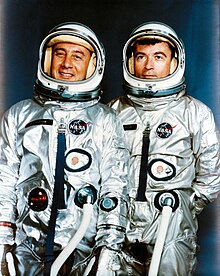
Back Gemini 3 Afrikaans Джемини 3 Bulgarian Gemini 3 Catalan Gemini 3 Czech Gemini 3 Danish Gemini 3 German Gemini 3 Spanish Gemini 3 Estonian جمینای ۳ Persian Gemini 3 Finnish
This article needs additional citations for verification. (March 2020) |
 Astronauts John Young and Gus Grissom walk up the ramp leading to the elevator that will carry them to the spacecraft for the first crewed Gemini mission | |
| Mission type | Test flight |
|---|---|
| Operator | NASA |
| COSPAR ID | 1965-024A |
| SATCAT no. | 1301 |
| Mission duration | 4 hours, 52 minutes, 31 seconds |
| Distance travelled | 128,748 kilometers (80,000 mi) |
| Orbits completed | 3 |
| Spacecraft properties | |
| Spacecraft | Gemini SC3 |
| Manufacturer | McDonnell |
| Launch mass | 3,237 kilograms (7,136 lb) |
| Crew | |
| Crew size | 2 |
| Members | |
| Callsign | Molly Brown |
| Start of mission | |
| Launch date | March 23, 1965, 14:24:00 UTC |
| Rocket | Titan II GLV, s/n 62-12558 |
| Launch site | Cape Kennedy LC-19 |
| End of mission | |
| Recovered by | USS Intrepid |
| Landing date | March 23, 1965, 19:16:31 UTC |
| Landing site | 22°26′N 70°51′W / 22.433°N 70.850°W |
| Orbital parameters | |
| Reference system | Geocentric |
| Regime | Low Earth orbit |
| Perigee altitude | 161 kilometers (87 nmi) |
| Apogee altitude | 225 kilometers (121 nmi) |
| Inclination | 32.6 degrees |
| Period | 88.35 minutes |
| Epoch | March 23, 1965[1] |
 Gemini III Patch  (L-R) Grissom, Young | |
Gemini 3 was the first crewed mission in NASA's Project Gemini and was the first time two American astronauts flew together into space. On March 23, 1965, astronauts Gus Grissom and John Young flew three low Earth orbits in their spacecraft, which they nicknamed Molly Brown. It was the first U.S. mission in which the crew fired thrusters to change the size and shape of their orbit, a key test of spacecraft maneuverability vital for planned flights to the Moon. It was also the final crewed flight controlled from Cape Kennedy Air Force Station in Florida, before mission control functions were moved to a new control center at the newly opened Manned Spacecraft Center in Houston, Texas.
© MMXXIII Rich X Search. We shall prevail. All rights reserved. Rich X Search